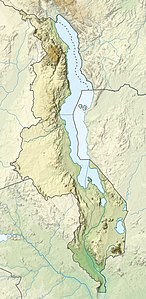Chongoni
| Chongoni | ||
|---|---|---|
| height | 2198 m | |
| location | Malawi , Dedza Province | |
| Coordinates | 14 ° 12 ′ 19 ″ S , 34 ° 12 ′ 10 ″ E | |
|
|
||
| particularities | Rock paintings (UNESCO World Heritage Site) | |
The Chongoni is a 2,198 m high mountain in Malawi , about 25 km north of Dedza in the province of the same name. The mountain and the surrounding hills are covered with the Miombo dry forest typical of the region and are a forest reserve. In its territory numerous sites are of rock paintings , to the list of the 2006 UNESCO - World Heritage site were taken.
Rock paintings
The 127 sites in an area of 126.4 km² represent the densest collection of rock paintings in Central Africa. They are still part of the living tradition of the Chewa people . The drawings to be found under overhangs and on large boulders belong to two clearly distinguishable origins.
The older, red drawings were from the Pygmäenvolk the Batwa made, the oldest may be up to 2,500 years old. They mainly represent abstract geometric figures such as halos, concentric circles, parallel lines and the like. This is where they differ fundamentally from the naturalistic rock paintings of other hunter-gatherer societies in southern Africa. It is assumed that their use was also different, for example for making rain or for fertility victims.
The more recent, white paintings are no more than 1000 years old. It is even believed that many were not made by the Chewa until the 19th and 20th centuries . They are one of the rare examples of rock art being practiced in agricultural societies. The older of these drawings presumably show mythological animal figures, were probably painted by women and are associated with female initiation rites. However, the exact connections are still kept secret by the Chewa.
The most recent drawings show masked animals. They are related to the still existing Nyau secret societies. They practice masked dances in funeral rituals and are important bearers of tribal identity, especially since the Chewa were forced into a defensive position by the Ngoni and European colonizers migrating from the south in the 19th century . While the rites are still carried out in close proximity to the paintings, the painting tradition itself has probably died out.
The Chongoni and the surrounding hills have been a forest reserve since 1924. Scientific descriptions of the drawings were first published in the 1950s. The five Chentcherere Caves were declared National Protected Monuments in 1969 and opened to the public.
The rock paintings have been registered as UNESCO World Heritage since 2006.
Individual evidence
- ↑ Bertelsmann World Atlas 2000
- ↑ UNESCO World Heritage Center: Chongoni Rock-Art Area. Accessed August 21, 2017 .


